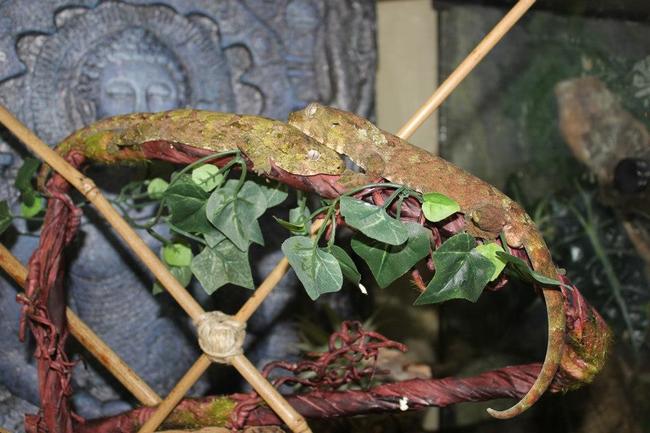Mnairogekko Chahoua
|
Chahouas, also called Chewies, Mossy (New Caledonian or Short-snouted) Geckos or Mnairogekko Chahoua are arboreal and nocturnal similar to the Crested Gecko. They are native to the island chain of New Caledonia in the Coral Sea (See History for maps).
Temperature and humidity: New Caledonia is a temperate rain forest with trade winds. The mild temperatures makes the native species very compatible with our home temperatures of 65F-78F. Many people keep Chahoua in a planted vivarium and so provide UVB light for the plants. I have noticed that mine will bask if given the opportunity and a warm spot of around 85. Like all cold-blooded species they are unable to thermoregulate (they are ectotherms-meaning they depend on their environment to help them regulate temperature from the outside) and require cool areas in the tank as well as warm. In addition they are sensitive to overheating and do not want sustained temperatures that are over the mid eighties. Humidity requirements are higher than the typical home and misting once a day, plus providing a humid hide or damp soil substrate and drinking bowl is required. Use a hygrometer and try to maintain 50-70% humidity. A larger shallow bowl placed in the cage will often be used by the Chahoua for bathing but will also require more maintenance as they will almost always defecate in it. If the cage is sprayed, leave one side dry so that the geckos can dry their skin if needed. Night time drops into the mid-high 60's are fine. Appropriate caging size in Exo Terra tanks: Juvenile 12x12x18, Adult 18x18x24, two adults 24x24x36. Vertical space is more important than horizontal space as these geckos like to climb. Natural substrates like peat and coir mixed together with leaf litter or ABG Mix hold humidity better than a reptile carpet or paper towels. It can also be used as a base for live plants or small insects to create a bio-active self-cleaning environment. Springtails and Isopods are two commonly used insects that act as cleaners for fungus and organic matter in a vivarium. Cork logs or stacked flats, Mopani wood, bamboo tubes and leafy vines are good cage furnishings for climbing and hiding. I keep a shallow large bowl for water that will get bathed in and defecated in and so need regular changing, an elevated magnetic shelf for a food dish and a smaller water dish for drinking. Elevating helps keep the food free of Isopods who can swarm a food bowl with Lemming-like persistence-leaving a nasty bowl of food and dead Isopods in the morning. It also keep the Chahouas from walking or defecating in the dishes. Scroll down for more information!
|
Color changes as an M. Chahoua matures
|
Their colors change dramatically as the gecko ages. Baby Chahoua hatch out looking black and white. Young juveniles typically have brown, black, white, with slight areas of red toned color (including peach and pink) in some cases. They are very plain compared to adult individuals. Theories about baby coloration include the neutral color giving them the ability to camouflage into rocks and tree roots after hatching out of eggs buried in the ground and while living at a lower elevation of the forest while they are young.
As they age their colors will become more visible and seem to spread as the brown and white areas change. The earth tones also turn to shades of green and often retain a lacy pattern. The colors and patterns vary from gecko to gecko and can be subtle and earthy to flashy and bright. The snout to vent length averages 5.5 inches and the weight ranges from 55-90 grams. Feeding: Their diet in the wild consists of insects, smaller lizards and fruit. In captivity their care is similar to the crested gecko (care sheet) but they do tend to like more protein in their diet and unlike a Crested Gecko, who will often refuse bugs, the Chahoua will almost always be happy to hunt them. In fact during growth and egg shelling periods they can become snappy unless given extra insects. Crickets seem to provide the most enrichment since the chahoua will chase them all over the enclosure, but Dubia roaches can also be used and have more protein to shell. Insects can be provided 2 times per week and should always be dusted with calcium. Once a month a mineral supplent such as Miner-all can be used. A powdered diet such as Pangea Complete Gecko Diet or Black Panther Zoological can be used every other day for most of their dietary needs. Treats of fresh diced or pureed fruit can be given once or twice a month. Mangos, papayas, bananas, blueberries, strawberries, raspberries and figs are popular but my experience is that sometimes the fruit is well received, other times it gets ignored. Try a puree or smoothy of blended fruit if diced doesn't go over well. Ripe to slightly over-ripe, sweet fruit is best. Breeding: Shelling females should be provided with a nest box and extra calcium should be provided in her enclosure. Even females who have never been with a male will produce infertile eggs once they reach sexual maturity. The eggs are heavier in calcium than other New Caledonian species like the Crested Gecko. Accordingly, Chahouas need more calcium in their diet. Dusting insects right before feeding them out as well as gut loading them 12-24 hrs before feeding helps. An open dish of calcium can also be left in the cage. If you are thinking of breeding, keep in mind that a female needs to be 2.5-3 years old before she can safely produce fertile eggs. A younger female will be in danger of developing Metabolic Bone Disease due to critical calcium loss. |










